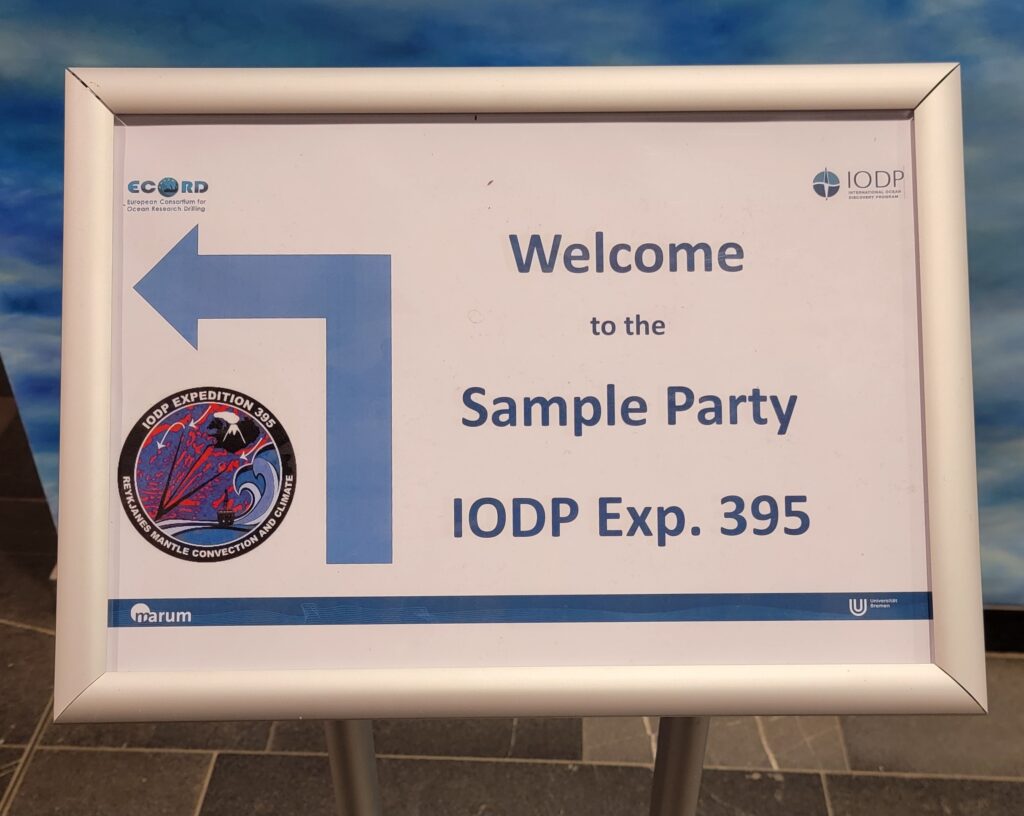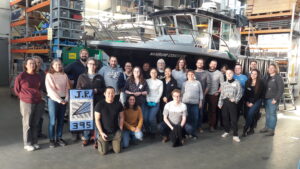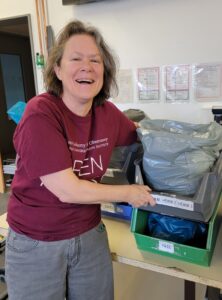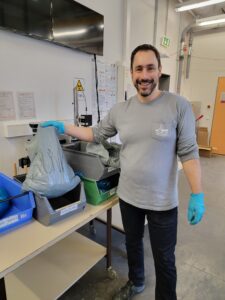
It’s more than a party!
written by Jennifer Field, Expedition 395 Onboard Outreach Officer

Five months after the return of Expedition 395, the science team has been reunited with a common goal: collecting approximately 19,000 samples from the cores taken during 395 and 395C. This reunion is delightfully termed a “sample party”. Instead of boutique cocktails and canapés, we have gathered in Bremen, Germany to extract pieces of the cores at precise intervals and locations based on the needs of the scientists. Sample requests were made months ago via a computer program which turned the scientists’ parameters into actual measurements on specific cores. It also recorded the needed volume of the sample and what type of method would be used to extract and package it. The program then created labels and QR codes for every sample. The laboratory technicians then put the labels on bags and organized the bags into batches based on the core. The cores were removed on large trolleys from the refrigerated storage unit and scientists pulled the appropriate core based on the sample bags. Scientists took every sample requested from a core regardless of whether it was for them or not.

Depending on the research objectives of the scientist, the samples varied in volume and collection method. Dr. Sidney Hemming has four main projects. One of these is to fully explore the benthic stratigraphy from 0-2.5 million years ago; while other scientists from the party are focusing on older samples, Dr. Hemming would like to be able to explain the apparent difference in the rates of accumulation during this time period. To do this, she had samples of 20 ccs taken roughly every four centimeters down the length of the cores during this time period. Dr. Hemming will also try to discover whether or not there is geochemical evidence in the sediments that mark the initiation of glaciation. Another objective of hers is to try to determine what the sand layers that were found in the cores from the east coast of Greenland (site 1602) can indicate about the history of the Greenland margin from the most recent glacial period to the Oligocene (30 my). This may include erosion history, climate changes, previous glaciation, and tectonic changes from the rifting which originally formed the North Atlantic basin. One last interest of hers is to study Glauconite. Glauconite is a mineral found in ocean sediments typically described as being formed in shallow marine environments. Dr. Hemming is unsure of the veracity of this assumption, as the distinct mineral is often found in deep ocean sediments. She hopes to clear up some of the mystery.

Dr. Tom Dunkley-Jones is researching biomarkers, in the form of alkenones, left by microscopic organisms called coccolithophores. Due to the processing of these samples, they must be protected from the soft plastic sample baggies, which give off similar chemicals during processing. These 20 – 30 cc samples were wrapped in foil before being put into the baggies. Through analyzing these samples, Dr. Dunkley-Jones hopes to look at the long term temperature change in the North Atlantic. Coccolithophores create alkenones (a type of fat) of different saturations depending on the temperature of the water that they are living in. By analyzing the saturation of the alkenones found in the fossilized organisms, a corresponding temperature can be inferred. This information is critical as current climate models are tested on the Pliocene climate and the initial indication is that they have not accurately predicted the ocean temperature. The models have predicted a cooler temperature than what has been found using this proxy data. The data from Expeditions 395 & 395C will add to the strength of the existing data for this time period.
The analysis of samples from these two expeditions will be ongoing for years to come and hopefully will lead to exciting discoveries for the 395 scientists and their colleagues.